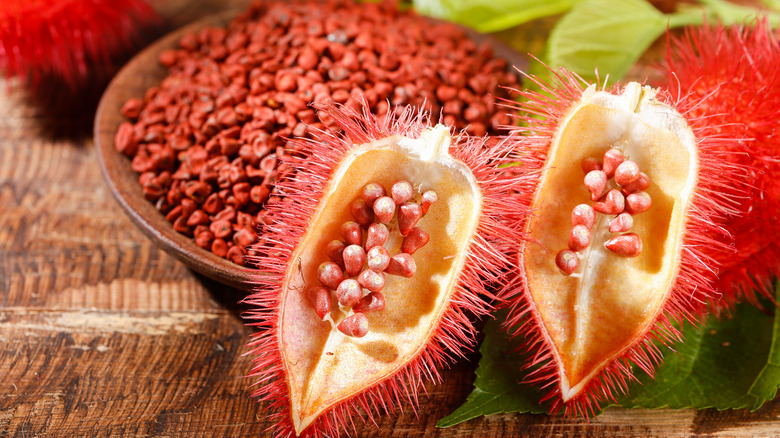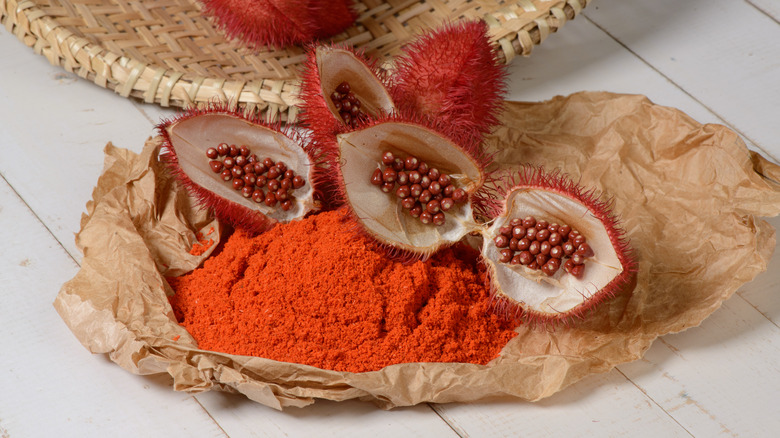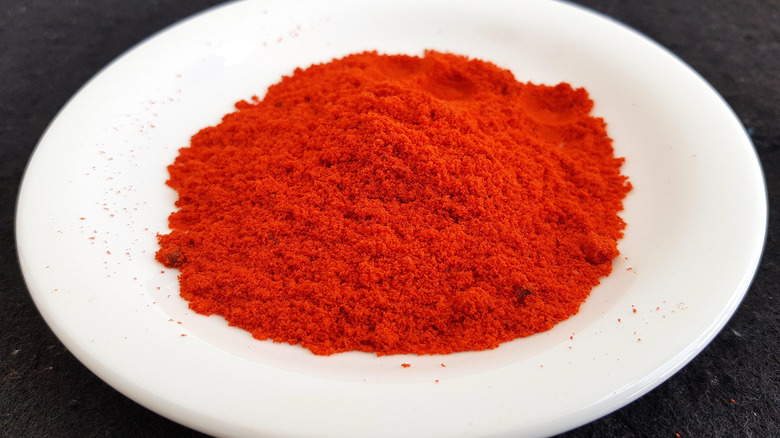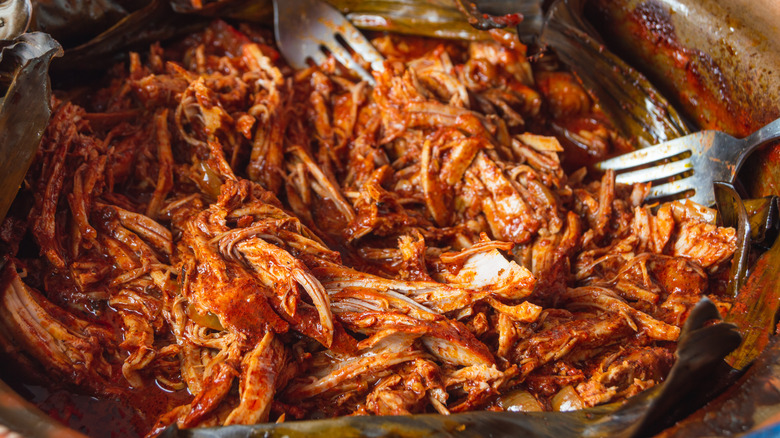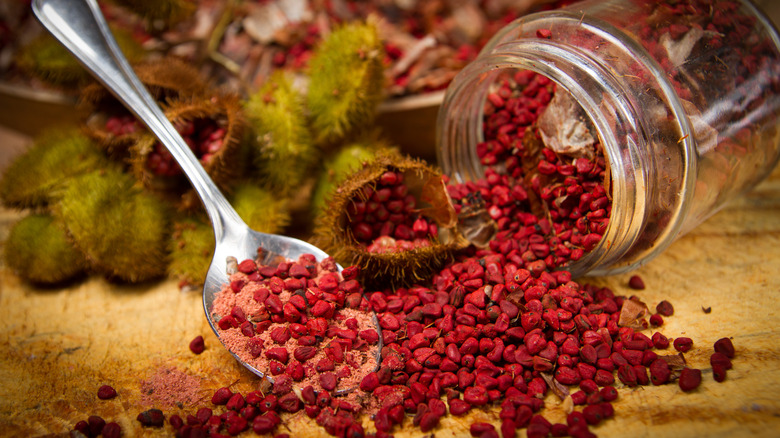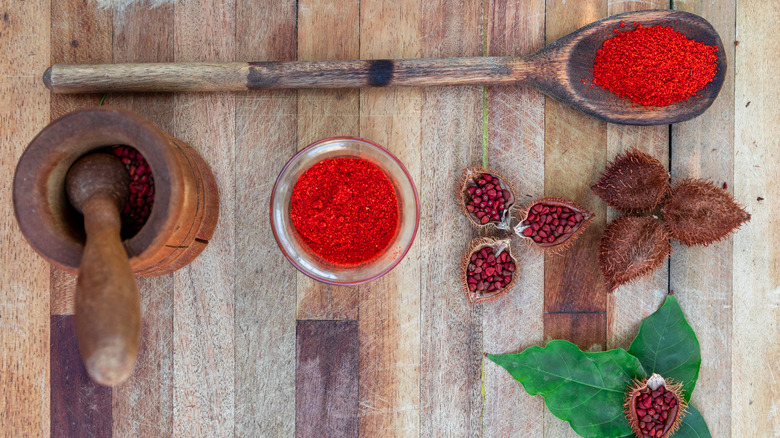What Is Annatto And How Do You Use It?
With all of those spiky, needle-like bristles on their exterior, annatto seeds are a little strange to look at. If you haven't heard of this tropical ingredient, don't feel too badly, since it's probably not something you're going to find listed in very many American recipes. It is, however, everywhere — as it is the source of an estimated 70% of natural food colorings, shares Healthline.
Per Organic Facts, annatto comes from a prickly brown and red fruit that grows in clusters on the tropical achiote tree, also known as the lipstick tree. When you crack open the fruit pod, you will find small red seeds, the treasure that is ground and used as a condiment or dye for many foods and cosmetics — and what people are talking about when they say "annatto." It is primarily found in Central and South America, and its color can be anything from a reddish orange to a brilliant yellow. Annatto is also known as achiote, poor man's saffron, onoto, or bija, among other names, depending on where you are.
What is annatto?
You've probably heard the phrase, "There's nothing new under the sun," and that definitely applies to annatto. It has been around for a long time. Smithsonian Magazine explains that the ingredient is probably responsible for the color of your favorite block of orange cheese, while Healthline shares that if you love the hue of your go-to stick of butter or margarine, you might want to thank this additive for lending its shade to the staple.
But before the modern-day food industry started using annatto to give our favorite cheddar its magical color, Mayans found it successful as a body paint, and Aztecs employed it to enhance the color of their drinking chocolate. At one point, it was even used as a sunscreen and bug repellant, according to Dr. Axe. These days, annatto continues to be just as useful, both as a coloring agent for food and as a mild seasoning for dishes from throughout the world. Generally, only the colorful pulp surrounding the seeds is used for processed foods, while the entire seed is used for cooking.
What does annatto taste like?
Annatto seeds have a peppery taste, while their aroma is often described as nutty and floral. The whole seeds are very hard and unpleasant to snack on whole, which is why they are usually ground or used to infuse oils. (A writer for Smithsonian Magazine chewed on a whole seed and found it "claylike." Maybe not a persuasive reason to try it.) However, annatto in its prepared forms can lend a slightly sweet, interesting depth of flavor to many foods — though it should not be used in large quantities because it can taste bitter.
Annatto pairs well with other spices, which is why achiote paste (more on this condiment later) usually contains additional ingredients and is used in recipes that have yet more flavorings. Common add-ins to achiote paste include black pepper, cumin, coriander, oregano, cloves, and citrus zest, all contributing to annatto's earthy, flowery notes. Chef Rick Bayless has said that achiote paste has "a flavor that tastes as though it's been unchanged since pre-Columbian times," according to the Smithsonian article.
Cooking with annatto
Annatto is available in a variety of forms. You might find it powdered and sold as "annatto" or in a spreadable substance called "achiote paste," though this will likely contain other spices unless it's homemade. If you're working with whole dried annatto seeds, you can steep them in cooking oil and use the infusion to add bright color and subtle flavor to a number of dishes, such as paella or a seafood stew.
Annatto is mostly used in cuisines from Mexico, parts of South America, some Caribbean islands, and the Philippines. If you want to cook with powdered annatto, you can simply toast it in cooking fat at the beginning of a recipe, then follow the rest of the steps as normal. This technique is used in pancit palabok, a chicken and shrimp rice noodle dish from the Philippines (via New York Times Cooking). If you prefer to experience the more full-bodied flavor of achiote paste, try making cochinita pibil, a heavily spiced, slow-cooked pork shoulder dish that hails from Yucatán in Mexico. Another option is to use it in the pork marinade for homemade tacos al pastor.
Where to buy annatto
Whether or not you've heard of annatto, you'll be able to find it at a wide range of grocery stores or online. If you're looking for ground annatto at supermarkets such as Walmart, Target, or Safeway, keep an eye out for brands that sell the product, such as McCormick and Badia, which also sells the whole seeds.
Other spice-aisle options include sazón, a seasoning blend containing ground annatto that is often used when making paella or a Spanish-style shellfish stew. Find it at the store from brands like Goya, or shop smaller brands online. Try similar sourcing options for achiote paste. For the widest selection of any of these products, look in Latin markets or on the internet.
Once you bring your annatto home, remember to store it properly. Whole or ground annatto can keep for years if stored in a dark, cool pantry, while homemade infused annatto oil should keep for a few months in the fridge if tightly sealed, according to The Spruce Eats.
Nutritional information about annatto
Annatto is more than just a pretty seed; it's also brimming over with nutritional value and possible health benefits. Healthline shares that while more research is needed on the topic, annatto may have some antimicrobial properties that can help with natural food preservation. Additionally, annatto is chock-full of antioxidants like carotenoids and vitamin A, as well as calcium, sodium, and iron, reports Organic Facts.
Annatto's high fiber content may aid healthy digestion, its carotenoids may support strong and long-lasting eyesight, and its calcium can contribute to sturdy bones. On top of that, the vitamin A found in annatto can naturally help improve skin appearance by preventing blemishes. Things to note: If you have irritable bowel syndrome, this colorful ingredient could exacerbate the condition. If you are diabetic, annatto does affect blood sugar levels, so you should talk to your doctor before adding it to your diet.
